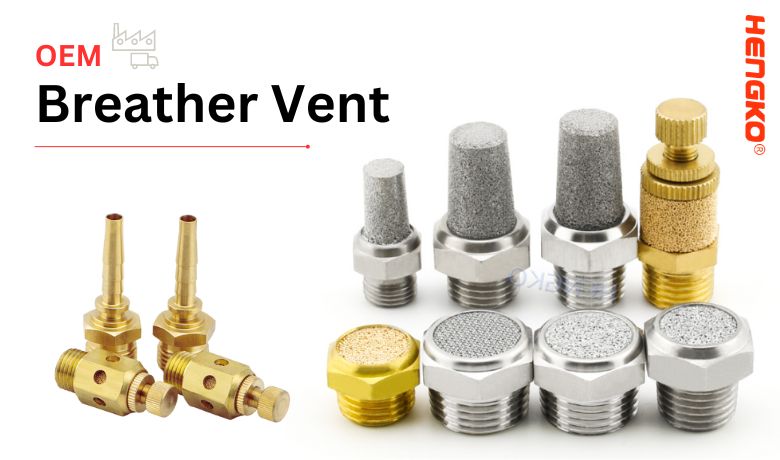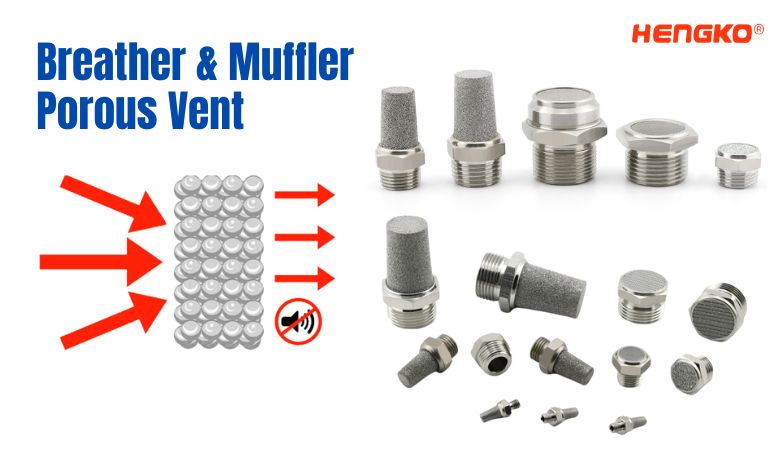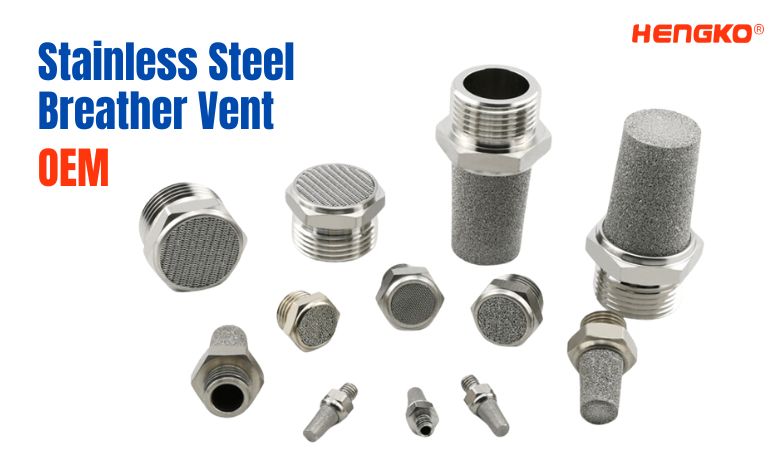-
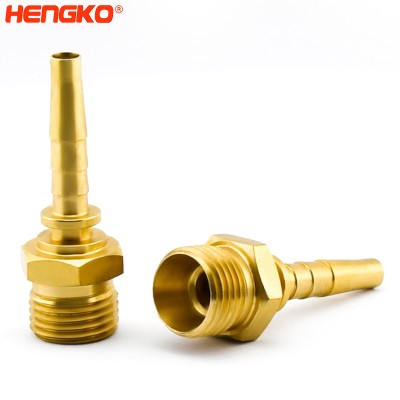
HENGKO Affordable porous powder metal sintered ax100 air pneumatic muffler
Pneumatic Sintered Mufflers Filters utitlize porous sintered bronze filter elements secured to standard pipe fittings. These compact and inexpensive mufflers...
View Detail -
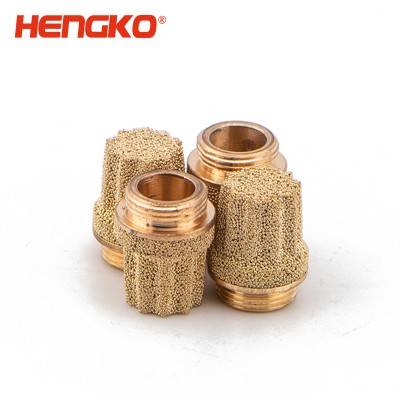
Breather vents with male thread, bronze brass stainless steel SS 316 ASP-1/2/3/4/6/8 BV
Pneumatic Sintered Mufflers Filters utitlize porous sintered bronze filter element secured to standard pipe fittings. These compact and inexpensive mufflers ...
View Detail -
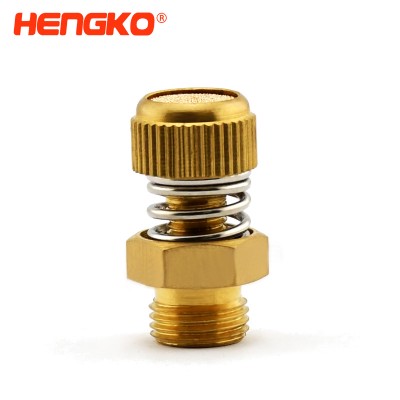
HB Micron Stainless steel Bronze Sintered Filter Element 1/4" Air Pneumatic Flow S...
HD Exhaust Muffler Bronze Model 1/8'' 1/4'' 3/8'' 1/2'' 3/4'' 1'' Pneumatic Sintered Mufflers Filters utitlize porous sintered bronze filte...
View Detail -
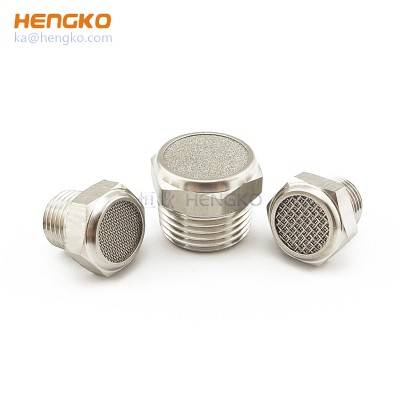
HBSL-MA V sintered brass pneumatic flat silencer muffler air exhaust noise reducing and...
Muffler Silencer Model G M5 1/8'' 1/4'' 3/8'' 1...
View Detail -

Brass air eliminator pneumatic muffler breather vent with 1/8” 1/4” 3/8R...
Pneumatic Sintered Mufflers Filters utilize porous sintered bronze filter elements secured to standard pipe fittings. These compact and inexpensive mufflers ...
View Detail -
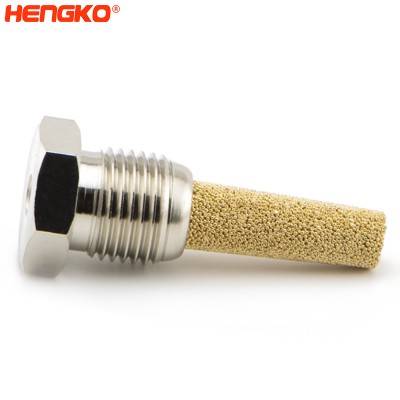
HENGKO Sintered Porous Metal Pneumatic components/ muffler return valve oil filter that...
Oil Valve Filter Bronze Model M5 M5 M5 1/8'' 1/4'' Pneumatic Sintered Mufflers Filters utitlize porous sintered bronze filter ele...
View Detail -
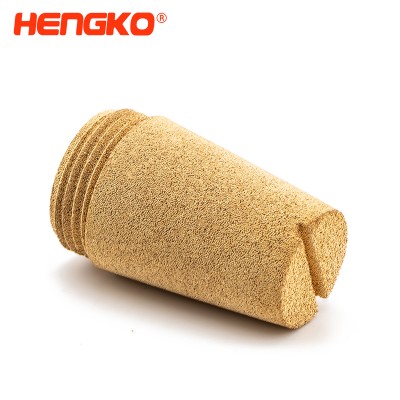
HSC Pneumatic Sintered Stainless Steel Brass Exhaust Muffler Silencer Fitting Noise Fil...
HD Exhaust Muffler Bronze Model 1/8'' 1/4'' 3/8'' 1/2'' 3/4'' 1'' 1-1/4'' Pneumatic Sintered Mufflers Filters utilize porous si...
View Detail -
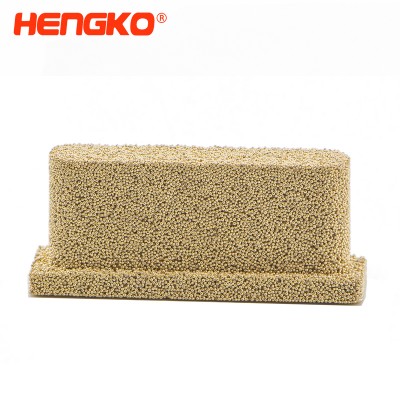
3 70 micron sintered micropore porous metal bronze copper exhaust muffler filter parts
Pneumatic Sintered Mufflers Filters utilize porous sintered bronze filter elements secured to standard pipe fittings. These compact and inexpensive mufflers ...
View Detail -

Porous Metal Sintered Stainless Steel Exhaust Muffler Silencers Flow Control Air Breath...
Pneumatic Sintered Mufflers Filters utilize porous sintered bronze filter elements secured to standard pipe fittings. These compact and inexpensive mufflers ...
View Detail -

Flow control exhaust muffler silencers porous metal sintered stainless steel air breath...
Pneumatic Sintered Mufflers Filters utilize porous sintered bronze filter elements secured to standard pipe fittings. These compact and inexpensive mufflers ...
View Detail -

Microns Pneumatic Plus Sintered Metal Bronze Breather Vent – Brass Body 1/4″...
Pneumatic Sintered Mufflers Filters utilize porous sintered bronze filter elements secured to standard pipe fittings. These compact and inexpensive mufflers ...
View Detail -

Industrial Sintered Porous Stainless Steel Air Silencer OEM and Wholesale
Pneumatic Sintered Mufflers Filters utitlize porous sintered bronze filter element secured to standard pipe fittings. These compact and inexpensive mufflers ...
View Detail -

Custom Pore Size Sintered Stainless Steel Porous Air Silencer
Pneumatic Sintered Mufflers Filters utitlize porous sintered bronze filter element secured to standard pipe fittings. These compact and inexpensive mufflers ...
View Detail -

50um Sintered Stainless Steel Porous Air Silencer Industrial Grade Available Now
Pneumatic Sintered Mufflers Filters utitlize porous sintered bronze filter element secured to standard pipe fittings. These compact and inexpensive mufflers ...
View Detail -
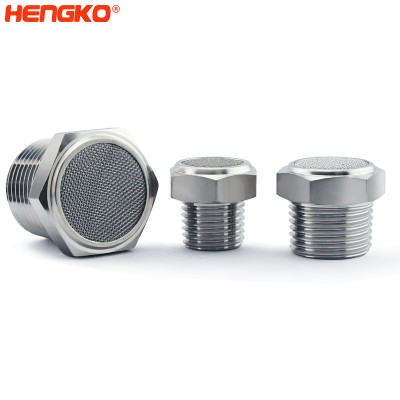
HBSL-SSDM Male Breather Vent Flat Sintered Mesh Pneumatic Air Silencer Mufflers Solenoi...
Pneumatic Sintered Mufflers Filters utitlize porous sintered bronze filter element secured to standard pipe fittings. These compact and inexpensive mufflers ...
View Detail -

5um Sintered Stainless Steel Gas Flow Restrictor for Laboratory Gas Chromatography Systems
3–5μm Sintered Stainless Steel Gas Flow Restrictor for Laboratory Gas Chromatography Systems and Other Applications Engineered for high-precision gas control...
View Detail -

Industrial Stainless Steel Mesh Air Silencer with Copper-Nickel Head | Durable & E...
Pneumatic Sintered Mufflers Filters utitlize porous sintered bronze filter element secured to standard pipe fittings. These compact and inexpensive mufflers ...
View Detail -
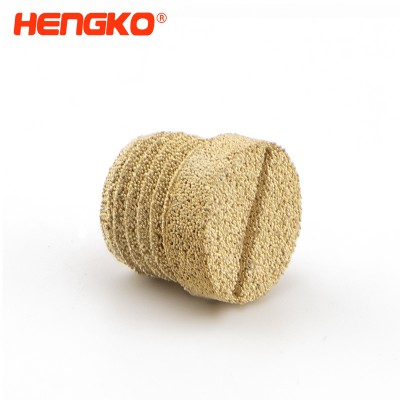
sintered porous metal powder bronze exhaust filter silencers fitting noise filter reduc...
Pneumatic Sintered Mufflers Filters utitlize porous sintered bronze filter element secured to standard pipe fittings. These compact and inexpensive mufflers ...
View Detail
Why Use Stainless Steel Breather Vent?
1. Equipment Protection:
Breather vents help protect sensitive equipment from contaminants like dust, water, and other particles which can adversely affect their functioning.
2. Pressure Regulation:
They prevent the build-up of positive or negative pressure within sealed units, which can cause leaks or component failures.
3. Moisture Control:
By allowing systems to "breathe", they can help prevent moisture build-up, which can lead to corrosion or other types of damage.
4. Temperature Regulation:
Fluctuations in temperature can cause pressure imbalances. Breather vents equalize this imbalance, ensuring consistent operational conditions.
5. Enhanced Lifespan:
By maintaining optimal internal conditions, they can prolong the lifespan of equipment and components.
6. Cost Savings:
By preventing damage and extending equipment life, they can result in long-term savings.
Types of Air Breather Vent
There are many different types of breather vents, each designed for specific applications and environments.
Here's a breakdown of some common categories you can clear to know :
By Function:
* Pressure and Vacuum Relief Vents:
These regulate pressure and prevent buildup or collapse within tanks, gearboxes, or other enclosures.
Examples include spring-loaded or weighted valves, and rupture discs.
* Moisture Breather Vents:
Allow air to circulate while preventing moisture ingress. Commonly used on roofs, fuel tanks, and electrical enclosures.
Examples include membrane vents, labyrinth vents, and desiccant breathers.
* Flame Arrestor Vents:
Prevent flame propagation into enclosed spaces through the vent by quenching flames with a fine mesh or sintered element.
Used in hazardous environments with flammable liquids or gases.
By Design:
* One-Way Breather Vents:
Allow air to escape during pressure buildup but prevent external contaminants from entering.
Used for applications where maintaining sterility or cleanliness is crucial.
* Two-Way Breather Vents:
Enable both pressure release and air intake, maintaining pressure equilibrium inside the enclosure.
Often used on storage tanks, gearboxes, and hydraulic systems.
* Open Breather Vents:
Simple vents with no filters or mechanisms, suitable for non-critical applications where dust or moisture
contamination is minimal.
By Material:
* Plastic Breather Vents: Affordable and lightweight, commonly used for residential and commercial applications.
* Metal Breather Vents: More durable and corrosion-resistant, ideal for harsh environments or industrial applications.
* Sintered Breather Vents: Offer high filtration efficiency and long lifespan, used for sensitive equipment or applications requiring clean air circulation.
Some Factor You Should Consider When Choose Breath Vent :
* Size and Threading:
Ensure the breather vent fits the opening and matches the existing thread size.
* Flow Rate:
Choose a vent with adequate capacity for the expected pressure relief or air exchange needs.
* Temperature Rating:
Select a vent material and design suitable for the operating temperature range.
Feel free to ask if you'd like me to delve deeper into any specific types of breather vents or their applications. I'm happy to help!

How does a breather vent work:
do you know how does a breather vent work ? then check as follow information.
1. Airflow Regulation:
The primary function of a breather vent is to allow air to flow in and out of a system, ensuring equilibrium between internal and external pressures.
2. Filtering Mechanism:
Breather vents often incorporate filters to block contaminants. As air flows in or out, it passes through this filter, ensuring that any dust, debris, or moisture is captured and doesn't enter the system.
3. Thermal Expansion and Contraction:
As temperature changes, air inside a sealed container expands or contracts.
A breather vent allows this air to safely escape or enter, preventing pressure build-up or a vacuum from forming.
4. Moisture Absorption:
Some advanced breather vents incorporate desiccants (like silica gel) to absorb any moisture from the incoming air, ensuring a dry internal environment.
5. One-way Valves:
Some breather vents use one-way valves, allowing air to flow only in one direction.
This can be particularly useful in applications where it's important to prevent any backflow or reverse circulation.
In conclusion, breather vents serve as guardians for various equipment, ensuring they operate under optimal conditions by balancing pressures, filtering contaminants, and controlling moisture. Their seemingly simple function can drastically reduce the risks of premature equipment failure and increase operational efficiency.
Main Features of Breather Vent
There are main features of breather vent, and we list some main, hope can help you understand more about breather vent.
1. Optimal Airflow:
Engineered to provide consistent and controlled airflow, ensuring equipment operates efficiently.
2. Moisture & Contaminant Barrier:
Protects internal components from dust, water, and other potentially damaging contaminants, enhancing the longevity of the device.
3. Durable Materials:
Main use Porous Sintered Metal, So Constructed from robust materials resistant to corrosion,
ensuring long-term reliability and minimal maintenance.
4. Pressure Regulation:
Helps maintain an equilibrium by equalizing internal and external pressures, preventing potential damage from pressure build-up.
5. Temperature Resilient:
Operates efficiently across a range of temperatures without losing performance.
6. Compact Design:
Streamlined and space-efficient, allowing for versatile installation in various applications.
7. Easy Maintenance:
Designed for simple cleaning and, if needed, component replacement, maximizing operational uptime.
8. Noise Reduction:
Minimizes operational noise, ensuring a quieter and more pleasant environment.
9. Safety Standards Compliant:
Adheres to industry safety and quality standards, ensuring user and equipment safety.
10. Versatile Applications:
Suitable for a range of industries and applications, from electronics to machinery and more.
If you're looking for specific features of HENGKO's Breather Vents, I would recommend reaching our
sales team directly or checking product specifications price by email ka@hengko.com
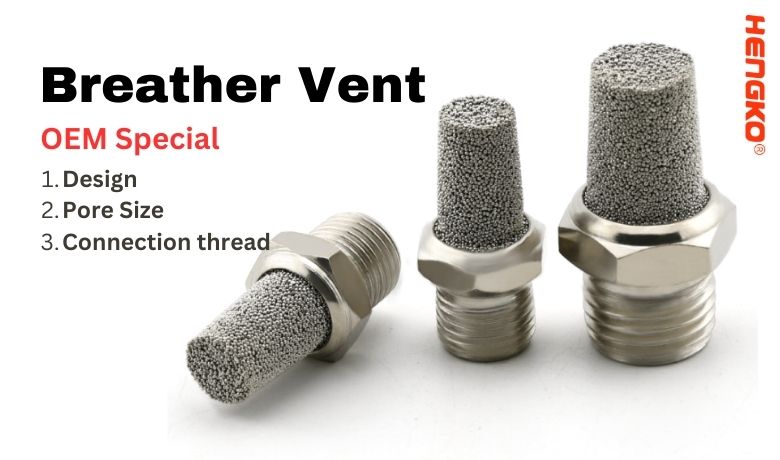
Choose Right Breather Vent You Should Consider
Choosing the right breather vent is crucial for the optimal operation and longevity of equipment. Here are several factors you should consider to ensure you select the appropriate breather vent for your application:
1. Application Needs:
Identify the primary purpose of the vent. Is it for pressure regulation, moisture control, or particle filtration? Understanding your primary need will guide your choice.
2. Material Compatibility:
Ensure the material of the vent is compatible with the environment in which it will be used. Some materials may corrode or degrade when exposed to certain chemicals or conditions
3. Pore Size:
The size of the pores in the vent determines the size of particles it can filter. Make sure the pore size matches the filtration needs of your application.
4. Flow Rate:
The vent should allow for an adequate flow rate to maintain pressure balance. This rate will vary depending on the size and needs of your system.
5. Operating Temperature:
Consider the temperature range within which the equipment will operate. Ensure the breather vent can withstand and function optimally within those temperatures.
6. Environmental Conditions:
If the equipment will be exposed to harsh environments, such as high humidity, saltwater, or aggressive chemicals, choose a vent that can resist these conditions.
7. Size and Fit:
Ensure the vent fits the space allocated for it and can be securely attached or integrated into your system.
8. Cleanability and Maintenance:
Some vents can be easily cleaned or backwashed to restore performance. Consider how easy it will be to maintain the vent over its lifespan.
9. Lifespan and Durability:
Opt for a vent that is durable and has a long service life, especially if it's for a critical application or will be challenging to replace.
10. Safety and Compliance:
Ensure the vent meets any industry-specific safety or quality standards, and check if it has been tested and certified by recognized bodies.
Stainless Steel vs. Bronze Breather Vents
Stainless Steel vs. Bronze Breather Vents
When choosing breather vents, selecting the right material is crucial for optimal performance.
HENGKO offers both stainless steel and bronze breather vents, each with its own unique advantages:
*Stainless Steel Breather Vents:
Known for their excellent corrosion resistance and durability, stainless steel breather vents are ideal for
harsh environments and applications where chemical exposure is a concern.
They offer high strength and are resistant to rust, making them suitable for outdoor and heavy-duty industrial uses.
*Bronze Breather Vents:
Bronze breather vents provide excellent filtration and are well-suited for applications requiring good thermal conductivity.
They are also effective in environments with moderate conditions and are often chosen for their cost-effectiveness.
Bronze is a popular choice for applications that do not require the extreme durability of stainless steel but still demand
reliable performance.
Whether you need the ruggedness of stainless steel or the cost-efficiency of bronze,
HENGKO can help you select the right breather vent for your specific application.
Comparison Table: Stainless Steel vs. Bronze Breather Vents
| Feature | Stainless Steel Breather Vents | Bronze Breather Vents |
|---|---|---|
| Corrosion Resistance | Excellent | Moderate |
| Durability | High | Moderate |
| Thermal Conductivity | Low | High |
| Strength | High | Moderate |
| Cost-Effectiveness | Higher cost | More cost-effective |
| Application Environment | Harsh, outdoor, chemical exposure | Moderate conditions |
| Suitability | Heavy-duty industrial use | General industrial use |
Whether your application requires the robustness of stainless steel or the efficiency of bronze,
HENGKO provides high-quality, customizable solutions to meet your air breather vent needs.
Where to use of Breather Vent ?
Here we list some Devices/Systems that Need Breather Vents:
1. Electronics Enclosures:
Breather vents protect the internal components from external contaminants while ensuring pressure equalization.
2. Hydraulic Reservoirs:
They use vents to maintain ambient pressure, preventing seal damage or leaks.
3. Industrial Gearboxes:
Vents help in pressure equalization and keep contaminants out.
4. Automotive Components:
Transmissions, differentials, and even battery enclosures often incorporate breather vents for pressure and contaminant management.
5.Bulk Storage Tanks:
As tanks are filled or emptied, breather vents prevent the buildup of excessive pressure or vacuum.
6. Medical Devices:
Sterility and consistent pressure are essential for many medical devices, from infusion pumps to ventilators.
7. Packaging Systems:
Especially for sensitive products, ensuring that no contaminants enter and that there's no pressure buildup is crucial.
8. Fuel Tanks:
Breather vents prevent excessive pressure or vacuum, which could result in leaks or other failures.
9. Pneumatic Control Systems:
They need vents to ensure consistent pressure, especially in applications where precision is vital.
10. Power Transformers:
As they can generate heat and gases, breather vents aid in releasing these gases and equalizing pressure.
11. Weather Instruments:
Devices that measure atmospheric conditions utilize breather vents to negate interference from internal pressure fluctuations.
12. Pharmaceutical Equipment:
From fermentation tanks to pill packaging machines, breather vents maintain sterile conditions and consistent pressures.
In summary, any device or system susceptible to pressure variations, environmental contaminants, or moisture can benefit from breather vents. They ensure consistent operation, prolong the lifespan of equipment, and often play a crucial role in maintaining safety standards.
FAQ
1. What is the primary function of a Breather Vent?
Answer: A breather vent's main function is to maintain pressure equilibrium within sealed units or enclosures, ensuring there's no buildup of negative or positive pressure. This balance protects equipment and systems from potential damages such as leaks, component failures, or structural damage. Moreover, breather vents filter contaminants, ensuring the internal environment remains clean and free from harmful particles, moisture, or other unwanted substances.
2. How does a Breather Vent differ from a regular vent?
Answer: While both breather vents and regular vents allow for airflow, breather vents typically incorporate filtering mechanisms that ensure only clean, particle-free air enters or exits a system. They often have precision-engineered pores that can block contaminants while allowing air passage. Additionally, breather vents are designed to manage pressure imbalances, while regular vents might not offer this level of regulation.
3. In which applications are Breather Vents most commonly used?
Answer: Breather vents find applications in a diverse range of industries. They are integral to electronics enclosures, protecting sensitive components from contaminants and pressure changes. Hydraulic systems, industrial machinery, automotive applications, and even medical devices often incorporate breather vents to ensure optimal performance and extend equipment life. Their ability to maintain pressure balance and purity makes them invaluable in numerous scenarios.
4. Are there different materials used in Breather Vent construction?
Answer: Yes, breather vents can be made from various materials, each offering distinct advantages. Common materials include porous sintered metals, polymers, and ceramics. For instance, porous sintered metals like stainless steel offer high durability, corrosion resistance, and precise filtration capabilities, making them ideal for challenging environments or applications requiring meticulous filtration.
5. How do I determine the appropriate pore size for my application?
Answer: The ideal pore size largely depends on the specific requirements of your application. If you aim to block out tiny particles or contaminants, a smaller pore size would be beneficial. However, it's essential to ensure that the chosen pore size doesn't excessively restrict airflow, which could hinder the vent's pressure-regulating function. Consulting with vent manufacturers or experts can provide guidance tailored to your needs.
6. How are Breather Vents installed?
Answer: Installation methods vary depending on the vent design and the equipment it's being attached to. Commonly, breather vents come with threaded fittings for easy integration into equipment. Some may require a sealant or an O-ring to ensure a tight, leak-free fit. It's crucial to follow the manufacturer's instructions and, when in doubt, consult with professionals or technical support to ensure proper installation.
7. Can I clean or replace the filters in Breather Vents?
Answer: Many breather vents are designed to be easily maintainable. Some feature removable and cleanable filters, allowing for extended vent life without compromising efficiency. In cases where filters are worn out or damaged, replacements are often available. Always refer to the manufacturer's guidelines on cleaning or replacing components to maintain optimal functionality.
8. How do I know when it's time to replace my Breather Vent?
Answer: Signs that a breather vent might need replacement include reduced airflow, noticeable pressure imbalances within the equipment, or visible contaminants bypassing the vent. Regularly inspecting and testing the vent's functionality can preemptively identify issues before they become problematic. Establishing a routine maintenance schedule can also extend the life of your vent and ensure consistent performance.
9. Are there any safety or compliance standards for Breather Vents?
Answer: Yes, various industries have standards and regulations governing breather vent design and functionality. For instance, in industries dealing with explosive or flammable substances, vents might need to adhere to specific safety standards to prevent accidents. Always ensure that the breather vent you choose meets or exceeds the required standards for your specific application.
10. Can Breather Vents handle extreme environmental conditions?
Answer: Many high-quality breather vents are designed to operate efficiently under extreme conditions, whether it's high temperatures, aggressive chemicals, or high humidity environments. However, it's crucial to select a vent specifically designed for such conditions. When in doubt, consult with the manufacturer about the vent's capabilities and resistance to particular environmental challenges.
11. what causes breath stacking on vent ?
Breath stacking on a ventilator, also known as double triggering or reverse triggering, occurs when the ventilator delivers additional breaths on top of the breaths initiated by the patient themselves. This can be a problematic situation as it can lead to overinflation of the lungs and discomfort for the patient.
Here are some of the main causes of breath stacking on a ventilator:
Patient-ventilator asynchrony:
* Double triggering:
This happens when the ventilator mistakenly interprets the patient's normal breathing patterns as trigger signals, delivering an additional breath before the patient has finished their own inhalation. This is more common when the ventilator's sensitivity is set too high, or when the patient has a high respiratory drive due to underlying lung disease.
* Reverse triggering:
This occurs when the ventilator's pressure or flow delivery triggers the patient's own inspiratory effort, leading to a stacked breath. This can happen with settings like low tidal volume or short inspiratory times.
Other factors:
* Airway leaks:
Leaks around the endotracheal tube or mask can cause the ventilator to misinterpret pressure changes and deliver extra breaths.
* Cardiac oscillations:
Pressure changes caused by the heartbeat can be mistaken for patient effort and trigger unintended breaths.
* Secretions:
Thick mucus in the airway can obstruct airflow and create pressure changes that might be misinterpreted by the ventilator.
----------------------------------------------------------------------------------------------------------------------------------------------------------------------------------
12. How to fix breath stacking on vent
Breath stacking on a ventilator, also known as double triggering or reverse triggering, can be a serious complication
that can lead to discomfort for the patient and even lung injury.
It's important to address it promptly to ensure the patient's safety and improve their ventilation.
So Here we supply some steps you can take to fix breath stacking on a vent:
1. Identify the cause:
There are several different factors that can contribute to breath stacking, so it's important to first identify the underlying cause.
Some common culprits include:
* Patient-ventilator asynchrony:
This is when the ventilator's settings don't match the patient's breathing pattern.
This can be caused by settings that are too sensitive, a low tidal volume, or a short inspiratory time.
* Airway leaks:
Leaks around the endotracheal tube or mask can cause the ventilator to deliver extra breaths to compensate for the lost pressure.
* Cardiac oscillations:
Pressure changes caused by the heartbeat can be mistaken for patient effort and trigger unintended breaths.
* Secretions:
Thick mucus in the airway can obstruct airflow and create pressure changes that might be misinterpreted by the ventilator.
2. Adjust ventilator settings:
Once you've identified the cause of the breath stacking, you can start to adjust the ventilator settings to correct it.
Here are some general tips you can try one by one:
* Increase the trigger sensitivity:
This will make it harder for the ventilator to be triggered by the patient's normal breathing patterns.
* Increase the tidal volume:
This will give the patient more air with each breath, which can help to reduce their respiratory effort.
* Increase the inspiratory time:
This will give the patient more time to inhale each breath, which can help to prevent them from triggering the ventilator too early.
* Decrease the expiratory time:
This will allow the patient to exhale more quickly
Hope those method will help you to find the best solution to fix breath stacking on vent for you.
-------------------------------------------------------------------------------------------
13. What is the difference between a relief valve and a conservation vent?
Relief valves and conservation vents both serve the purpose of pressure or vacuum relief in a system, but they differ in their function, application, and standard compliance. Here's a breakdown of the key differences:
1. Function:
* Relief Valve:
2. Application:
* Relief Valve:
Standard Compliance:
Here's a table summarizing the key differences:
| Feature | Relief Valve | Conservation Vent |
|---|---|---|
| Function | Emergency pressure relief | Pressure/Vacuum control during operation |
| Application | High-pressure systems (pipelines, boilers) | Storage tanks for liquids with vapors |
| Standard Compliance | Stricter regulations (API, ASME) | Venting standards (API, EN ISO) |
In simpler terms, a relief valve acts like a safety release valve in case of emergencies, while a conservation vent functions as a pressure/vacuum regulator for maintaining optimal conditions during normal operation.
Don't compromise on the efficiency and lifespan of your equipment. With HENGKO,
you're not just choosing a breather vent; you're investing in top-tier quality, expertise, and reliability.
Get Expert Guidance Now!
Reach out to HENGKO at ka@hengko.com and ensure your systems breathe easy with the best vents
in the business. Your equipment deserves nothing less!
